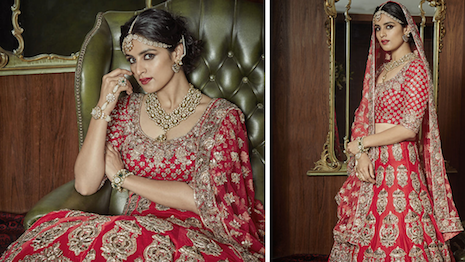 Manish Malhotra is one of India's most popular luxury apparel designers. This photo: the Manish Malhotra bridal collection. Image credit: Manish Malhotra
Manish Malhotra is one of India's most popular luxury apparel designers. This photo: the Manish Malhotra bridal collection. Image credit: Manish Malhotra
By Abhay Gupta
Customer retention is imperative for business to remain competitive. It has recently become much more significant as compared to just simple customer acquisition. This, specifically, is further accentuated in the luxury business.
India's growing luxury consumer base has the money to splurge, but wants a clear and real value proposition from luxury brands.
This treatise focuses on the unique challenges in customer relationship management as faced by luxury marketers in India.
A primary study was conducted through an online questionnaire sent to brand leaders and managers representing the luxury business across sectors in India. The responses and analyses emerged with not only interesting challenges, but also the strategies to combat them.
Issues and challenges in customer acquisitions and customer relations management
Brazil, Russia, India and China are emerging markets with rapidly increasing consumer spending in the luxury sector. These markets value status and luxury more than any other demographics of the world. Besides, these are predicted to have the largest base of luxury consumers.
The Indian luxury landscape is experiencing strong evolutionary undercurrents that are redefining the consumer profile and how luxury players will need to operate in this domain.
In the last few years, luxury in India has been growing at a compounded annual growth rate (CAGR) of about 25 percent. As per a recent report by industry trade body ASSOCHAM, the market, from its 2015 size of $14.7 billion, was expected to hit $18.6 billion by 2016.
Service areas such as fine dining, electronics, luxury travel, luxury personal care and jewelry saw increasing revenues and are expected to grow by 30 percent to 35 percent over the next three years. Spending on luxury cars continue to rise growing upwards at 18 percent to 20 percent over the next three years.
Luxury is no longer the privilege of the few who were born into wealth. There is now a larger consumer base, which has the money to splurge but wants a real value proposition. This will be the biggest challenge faced by luxury brands.
With the trend of luxury consumption changing from “having” to “being,” more millennial luxury consumers want to enjoy the luxury of owning the product, but are questioning the need to splurge on the latest collection with no clear value proposition besides being the ‘first to own it.’ These consumers are bright shoppers who study the brand and its creation before initiating a buying decision.
Retaining customer loyalty with top-tier luxury consumers is always going to be a challenge for the brands in emerging markets such as India. The brand has to keep up with the constant changes on economic factors, fashion trends, competition amongst other retailers and talent retention.
A close study on different consumer behavior from emerging markets, specifically from a country such as India, would be fundamental in making the luxury brand successful.
Diverse strategies are needed in handling different demographics for brands to be unbeaten in luxury. Luxury experiences, both in-store as well as online, is of prime importance for consumer retention.
It is important for the luxury retailer to understand where the loyalty lies in the mind of the luxury consumer: whether it is the brand itself, or the designer of the collection, or the aesthetics of the product or the strong relationship with the personal shopper who has enormous influencing power in persuading top-tier clientele in their purchase decision.
Also, often disconnection between the corporate strategies and a misaligned mission and vision with the retail lineups might also lead to customer dissatisfaction, resulting in loss of sales.
With social media and digitalization taking a strong grip on the luxury business, efficiency needs to be enhanced at the store level to give customers a unique luxury shopping experience.
The objective of this paper is to comprehend first India's rising consumer segment and their preferences; next, issues and challenges faced by luxury brands in handling expectations and deliverables; and finally, maintaining customer relationships with Indian luxury consumers.
The paper through its primary study attempts to understand how organizations are crafting a consumer focus environment and enriching the luxury customer experience through care-optimizing processes, thus generating opportunities and meeting the lifetime need of the Indian luxury customer.
Understanding the Indian consumer
The luxury goods business in India is one of the world’s most diverse, exciting and challenging markets for brands seeking a presence here.
Brands and retailers that want to capture a share of this fast-paced business need to learn to adapt, or risk missing one of the next-greatest untapped opportunities for the luxury business.
As more brands enter India with renewed strategies, Indians traveling to London, New York or Dubai for a few weeks and coming back with bags full, is gradually becoming a thing of the past.
The following are the key types of customers identified in India:
1. The old money consumer (the original maharaja and nawab): Born with a silver spoon, the old money group has inherited wealth. Hence, luxury is a way of life for them. These are absolute luxury consumers who want exclusivity and customization.
The elitist, original, sophisticated, upper class spillover from the erstwhile nawabs and kings, despite the privy purse restrictions, have continued their traditional conspicuous consumption all through the post-independence decades and have not been dependent on the new wave of luxury goods into India. The key driver for them is individuality, personalization and a special effect, just for them.
2. The new money consumer (the New Age maharaja): Created after India’s industrialization phase of the 1960s, the new industrialists, the new rich and the new factory owner by now is a staunch consumer of luxury goods. They earned the wealth themselves and want value from the products they buy.
While the older generation prefers spending on safe assets such as jewelry, their successor generation tries to pull them out of the closet and spend on trendy items.
3. The returning non-resident Indian (NRI): This group is well educated, well exposed and tech-savvy.
As more globetrotting NRIs make their way back to re-settle in India, the luxury business has hugely benefitted.
Used to a certain standard of living and service that they have experienced abroad, they seek the same in India. Particular gains have been seen in luxury real estate, home decor and hospitality, as well as in fashion and gourmet experiences.
4. The corporate professional: The management graduate with multinational-corporation income; the DINK (double income, no kids); the HENRY (high-income not rich yet); and the YUUMY (young urban upwardly mobile) shops luxury like there is no tomorrow. They need to dress well, drink well, eat out frequently, socialize, entertain, chill out or just hang out – basically live well and live for today.
Luxury automobiles to latest mobile phones to seasonal wardrobe changes: they are the next big spenders on all things luxury.
5. The bargain hunters: This class is visible in large numbers during EOSS (end of season sales). They are value driven and keep looking for more. They can make impulsive decisions for a seemingly good deal falling in a “value trap.” This is a fast-growing class that fuels the demand for all entry-level accessible luxury products.
Inferences
From the above survey, the following could be concluded:
1. Indian luxury customer demographics may be summarized as follows:
-- 25 percent of actual shoppers are around 25 years of age
-- 50 percent of actual shoppers fall into the 30-50 years age bracket
-- 25 percent of shoppers are in the 50-plus years age bracket
-- The male to female ratio of consumers is almost equal
-- The majority of these spenders are in the new money and corporate spender categories
2. Justifying the high price of a luxury product is one of the biggest challenges faced by a new-entrant luxury brand in India.
3. Once the Indian luxury customer makes up his mind, he gives least importance to the “cost versus functional value proposition,” while giving most importance to “in-store staff interactions.”
4. “Prompt and assured service” is what the customer gives most importance to, per the findings of the paper. This clearly concludes that staff training and skills enhancement is a key requirement for any brand to succeed.
5. Fifty percent to 75 percent of customers make repeat purchases with the same brand if serviced well. Attention needs to be paid to pre- and post-purchase customer service.
6. Public relations activities and personal shoppers are the preferred – hence, suggested –methods of creating brand awareness and brand engagements.
7. Customers give a lot of weightage to the loyalty program and special event engagement on offer. Hence, luxury brands need to continuously develop and improvize such activities.
8. Almost 75 percent of the consumers follow a luxury brand digitally. Hence, a good strategy would be to develop a physical, digital and social media engagement with the customer.
9. Most Indian luxury consumers do not use the digital medium to voice any complaints.
10. A India-specific digital strategy including a India-specific Web site is suggested for most existing luxury brands.
11. Most brands have also developed a special India-specific marketing and communications strategy.
Road ahead
Luxury comes a full circle in India. India is not new to luxury brands. What was Western luxury brands' biggest consumer base during the times of the maharajas and nawabs is once again the target market for the same brands.
This time, it is the new maharaja and nawab, the new corporate HENRY, the new young pulsating India, that is driving in sales of luxury goods.
This customer has dreams and expectations. He or she wants luxury to provide a personalized, customized and Indianized experience.
India's new breed of consumer indulging in luxury goods and services is expecting a more cherished luxurious experience.
Luxury brands should engage themselves in creating a brand connect with the consumers through media, PR and special events.
Provide closeness, uniqueness, and product and brand acquaintance with appropriate messages. Educate this new Indian customer with your value proposition: reach out, engage, inform, indulge, entertain and then retain.
This customer is loyal and will remain with the brand if assured prompt service, efficient sales staff, continuous engagement and mutual respect.
With varied types of customer categories, it is imperative to connect and convert the first-time walk-in client in a luxury store.
Per the study, store staff interaction stood out as one on the most important parameters for customer conversion and retention. Sales staff can elevate consumer involvement with the brand, both emotionally and materially.
For closing the sale and retaining repeat customers, brands must deliver influential, enlightening and touching experiences, since the physical store experience is the most memorable form of communication that a luxury brand can offer.
Organizations need to create value experience through the digital platform in alignment with the store experience.
A VAST NATION, multitude of cultures, unity in diversity and a majorly young population makes India a distinct consumer base for the luxury business.
Brands focusing on an India-specific strategy and connecting with the local Indian consumer will triumph most in the coming years.
This abstract and findings are based on a paper written and presented by the author at the SMU-LVMH conference, Singapore May 2015. It has now been published in a book ‘The Essence of Luxury: An Asian Perspective,’ in October. For a complete copy of the survey, please contact the author.
 Abhay Gupta is founder/CEO of Luxury Connect and Luxury Connect Business School
Abhay Gupta is founder/CEO of Luxury Connect and Luxury Connect Business School
Abhay Gupta is founder/CEO of Luxury Connect and Luxury Connect Business School, Gurgaon, Haryana, India. Reach him at abhay@luxuryconnect.in.